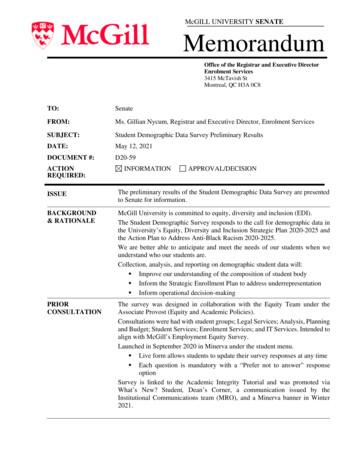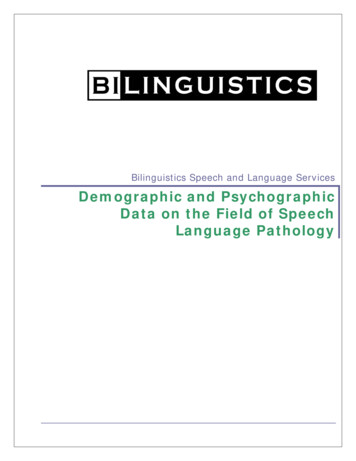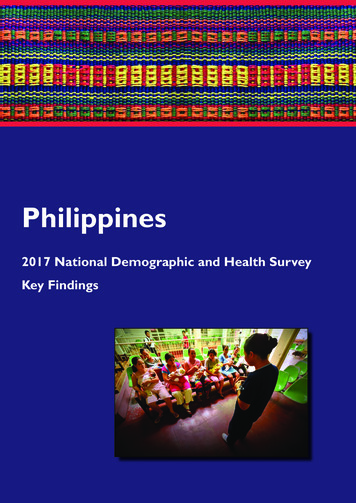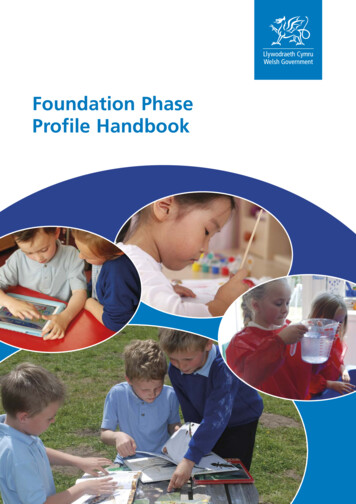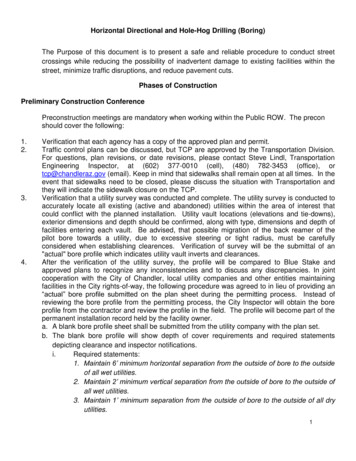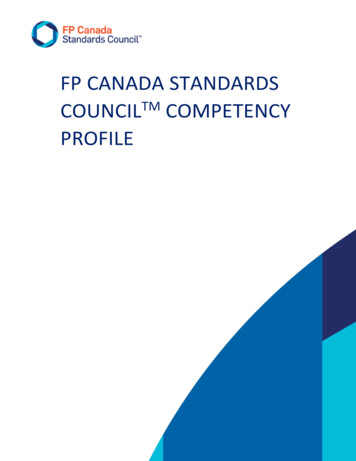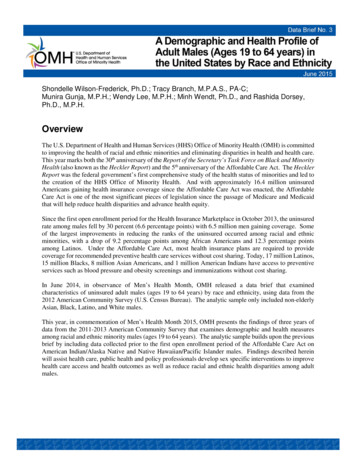
Transcription
DemographicsA DemographicProfile of Childrenin Memphis andShelby County
A Demographic Profile of Children in Memphis and Shelby Countywhy it’s important:Demographics are important because the numbers of children in different age groups, the ratio of children to adults, and the social and economic characteristicstypical of families with children have implications for community resources. Demographics alsocapture a multitude of indicators relevant to early child development and well-being for children.Poverty is a highly reliable basic indicator for risk, and, to a great degree, can factor out raceand ethnicity as direct causes of different child outcomes. In Memphis and Shelby County raceand ethnicity are associated with poverty and other risk factors and remain critical demographicindictors because particular risk factors, such as early child-bearing and absence of adequatemale support, are associated with race and ethnicity in this country; neighborhood influenceson poverty, parenting, and child development are associated with residential segregation, andbecause race relations are a factor in how communities grapple with problems of children.Sources: Census 2000 and American Community Survey 2004, unless otherwise noted. Census 2000 data offers a baseline for demographictrends in Memphis and Shelby County. Beginning in 2002, the American Community Survey provides annual updated estimates but typicallyprovides less detail than data from the census. For example, detailed breakdowns by race and ethnicity or special calculations such as childrenbelow the “low income” level are associated with census years only. Data below represent the most current data available from secondarysources. Data for some ethnic groups are not presented in some graphics when populations are small or under-represented by census samples(e.g. Asians and Hispanics) or when the emphasis is on comparing patterns between the two largest racial/ethnic groups in Shelby County –blacks and whites. Some data calculations are readily available only for Memphis or only for Shelby County. All data for Shelby Countyincludes the City of Memphis in the overall figures. Summary estimates and conclusions not accompanied by graphics represent author’s interpretation of data available from census and other sources.1
The 2004 American Community Survey estimates 246,205 childrenlive in Shelby County, of which 165,096 (67%) live in Memphis.1Distribution of Children by Age Group for Shelby County and within 60820,00010,0000Under 5Ages 5-9Ages 10-14Memphis City OnlyAges 15-17Ages 18-19Shelby County TotalKey Finding: The number of children in Shelby County appears to be fairly stable as a cohortof children moves from pre-school age to elementary to high school age. (Note that the last twoage categories combined equal the five-year groupings of the first three age categories.) The distribution of children throughout the county is changing.2While Memphis accounts for 74 percent of Shelby County’s population, the cityaccounts for only 67 percent of children in Shelby County. Suburban Shelby Countyfamilies have a disproportionate impact on county resources.The continued increase in families with children in suburban Shelby County bycontrast is putting pressure on existing schools and other resources.The demolition of public housing and other dilapidated housing in Memphis is shiftingpopulation to other Memphis neighborhoods, especially neighborhoods with densemulti-family developments.Diminishing population in inner-city neighborhoods is creating a mismatch betweenexcess classroom capacity and the diminished school-age population in some Memphisneighborhoods.Children’s services and organizations serving inner-city neighborhoods report decliningparticipation, while children moving to new neighborhoods may have too few opportunities for recreation and other healthy activities.1, 2 Most data in this report are for children under 18. Some data—such as school enrollment, can include children 18 and 19, whileteen births are most often calculated for girls 15 to 19. We have included 18 and 19 year olds in this chart for convenience, adding23,773 18 and 19 year olds for Shelby County—of which 18,608 are in Memphis.2
Race and Ethnicity of Children in Shelby County, 10%3,9174,6180%BlackWhiteHispanicAsianOtherRace and Ethnicity of Children in Memphis and Suburban Shelby County, teMemphisHispanicAsianOtherSuburban Shelby Co.Key Finding: The high proportion of black children in Memphis and Shelby County meansthat what happens with black children—and increasingly, Hispanic and other immigrant children—will have a profound impact on the future of both Memphis and Shelby County.While they are still under-represented in suburban Shelby County compared to the Cityof Memphis, black, Hispanic, and other immigrant children account for over 20 percentof suburban children.3
Distribution of Population Under 5 by Race and Ethnicity, lackWhite4.1%3.6%1.9%1.7%2.5%2.6%Shelby Co.HispanicMemphisAsianOtherDistribution of Population Age 5-17 by Race and Ethnicity, lackWhite2.3%1.4%1.5%Shelby Co.Hispanic4Asian2.6%1.2%1.3%MemphisOther
Child Population by Race and Ethnicity, lackWhite1.6%1.3%1.8%1.5%2.7%3.0%Shelby Co.HispanicAsianMemphisOtherKey Finding: Compared to the State of Tennessee and the nation, the future of children, theeducational system, and the labor force in Memphis and Shelby County depends on the outcomes of black children.Critical Issue: Risk factors for child development are widely distributed.3Memphis has a very high proportion of neighborhoods with moderate-to-high-risk indicators for early child development, with 55 percent of census tracts scoring moderateto high on the Child and Family Policy Center’s Index of Child Vulnerability.While Shelby County outside of Memphis scores low in vulnerability, with onlytwo tracts scoring moderate-risk, moderate-risk indicators have become evident in predominantly black, middle-class Memphis neighborhoods.The relationship between high-poverty neighborhood environments of the inner-cityand child outcomes might weaken, with negative outcomes becoming more evidentin formerly low-risk neighborhoods, or more favorable neighborhood environmentsmight absorb additional risk factors and support positive outcomes.3 The Child and Family Policy Center’s Index of Child Vulnerability is discussed in greater detail in “Community Environment”5
Key Finding: Fifty-five percent of City of Memphis census tracts (90 tracts) and 43 percent ofMap 1: Census Tracts by Neighborhood-Related Risk Factorsfor Early Childhood Development with Zip Codes and Major RoadsShelby County as a whole, score moderate-to-high on the Index of Child Vulnerability. Allhighest risk tracts are in Memphis, where 48 out of 163 tracts (22%) are high risk.6
7
Key Finding: The Hispanic population in Shelby County is growing. With concentrationsof families in particular neighborhoods, special challenges are posed for public schools and positive educational outcomes for this largely immigrant group of children.Key Concept: The Age DistributionThe ratios of children to working adults and to the elderly influence the demand forschools, child care and other child-oriented services, as well as the tax base to pay forthem and the receptivity of the political climate toward children’s issues.The percent of children in the population is a product of the birth rate and family size,whether adults in their working years are well-represented in the population, and whetherolder and retired adults are remaining or have died or moved away.The percent of school-age children in Memphis (23% of the total) is 27 percenthigher than in Nashville (18% of the total). That creates a special funding challengein Memphis.Age distribution among working adults typically represents economic opportunities.In this regard Memphis fares poorly while suburban Shelby County fares much better.The percent of children in a population also is higher if health issues lower life expectancy, thereby reducing the proportion of older people in the population. The under-representation of older people in Memphis compared to suburban Shelby County, for example,represents poor health and increases the child population proportionately.Age Distribution for Black and White Populations in Shelby County by Number, 65-6970-7475-7980-8485 015,14014,27013,5607,8616,472Age8
Age Distribution for Black and White Populations in Shelby County by Percent, 0-4445-4950-5455-5960-6465-6970-7475-7980-8485 %AgeKey Finding: Age distributions for black and white populations in Shelby County reflect anidentifiable “age gap.”Since mid-career families with children moving to Shelby County are more likely to bewhite than black, the distribution of the white population in Shelby County reflects alarger proportion of older adults and a closer fit between the proportion of children andadults than among the black population, where closer analysis reveals that mid-careerage families are likely to relocate outside of Shelby County.9
Critical Issue: High percentage of children poses challenges for Memphis.Both Memphis and suburban Shelby County have higher than expected percentages ofchildren (compared to the national demographic baseline), but for different reasons andwith different outcomes.In suburban Shelby County 31 percent of the population is under 19, compared to 28percent in Memphis and only 22 percent in the US. In the suburbs the high percentagereflects a high proportion of family households. In Memphis, there are more single-person and other non-family-unit households. More adults are, therefore, “child-centered”almost by definition, which helps to cushion the challenge of the high concentration ofchildren and bolster the constituency for expansion of suburban schools.In Memphis the high percentage of children is not accompanied by a high incidence offamily-unit households, but by fewer adults in family households, the likelihood thatworking-age adults will be unattached to family households, and the apparent emigrationof working-age adults, including a disproportionate share of two-parent households.National demographic patterns demonstrate a great deal of stability in the number ofadults entering the age-25-to-44 cohort, meaning that there are at least as many 44-yearolds as 25-year-olds in the U.S. With immigration (and the tail-end effects of the babyboom), the number of adults at the upper end of the cohort is actually 20 percent higherthan the number of those entering.While the age-25-to-44 cohort is stable in suburban Shelby County, indicating both thatyounger people are likely to stay and that newcomers move to the suburbs from elsewhere, in Memphis the cohort diminishes by 11 percent. The primary cause is emigration, but mortality and incarceration also play a role.National demographic patterns for the transition from the age-45-to-54 cohort to theage-55-to-64 cohort reflect the effects of delayed child-bearing during WWII and thebaby boom that followed. The older cohort is 30 percent smaller nation-wide because ofthe size of the baby boom and the normal increase in mortality between the ages of 55and 64. For Memphis, however, the 70 percent drop between cohorts reflects other influences, including early waves of suburbanization among white Memphians, movement ofolder and better educated black Memphians to higher-opportunity growth areas, andhigher mortality rates among less healthy adults most likely to remain in Memphis.The City of Memphis is strained as much because of diminished representation of working-age adults and comparatively low property values as by family size and birth rates.Diminished representation of working-age adults also means less “human capital” available to support child development through informal networks in extended families andneighborhoods, as well as for more formalized community-wide efforts.10
Critical Issue: Teen births in Shelby County are significant.4Birth rates for black women and white women of child-bearing age in Shelby County(15-44) are 79 and 62 births per thousand women, respectively. The higher rate amongblack women is due almost exclusively to earlier child-bearing. More black women aremothers at any given time because of the higher rate of births to teens. This does notmean that starting earlier necessarily results in more children per mother, but there issome relationship between starting earlier and larger family size.White families with children in Shelby County average 1.5 children per family, which iswell below the national average of 2.1 children. This suggests that white families areolder and more likely to have adult children, a pattern born out by the age distribution ofwhite families in Shelby County.Black families in Shelby County, on the other hand, average 2.1 children, which is higher than white families locally, but well within the national norm for family size. Nationaldata suggest that better-educated, middle-class, black women actually have fewer children than their white counterparts. This means that the higher average number of children for black women in Memphis is largely attributable to higher birth rates amongyoung women who become mothers as teens, and who are likely to have less educationand come from low-income families.The birth rate for black females between the ages of 15 and 19 in Shelby County hasdecreased since the 1990s. Nevertheless a birth rate of 80-per-1,000 females in 2003means that 8 percent of these teens give birth in a given year and about 35 percentbecome mothers between the ages of 15 and 19. Based on historical data, between 15and 20 percent of these mothers are likely to have a second child. Considering all birthsto black females of child-bearing age, 20 percent (1,600) were to teen mothers in ShelbyCounty in 2003. These births have a high probability of being non-marital.The birth rate for white females between the ages of 15 and 19 in Shelby County hasincreased since the 1990s. The birth rate of 33-per-1,000 girls in 2003 means that 3.3percent of these teens give birth in a given year, and that 16 percent become mothersbetween the ages of 15 and 19. Considering all births to white females of child-bearingage, 7 percent (432) were to teen mothers in Shelby County in 2003. These births havea high probability of being non-marital.Black teens are 2.4 times as likely to become mothers as white teens. Considering thatwhite girls in Shelby County are more likely to come from families with higher educationand income, it appears (and merits further research) that black middle income girls inShelby County may actually be less likely than their white counterparts to become teenmothers. There appears to be a protective factor for black, middle-income girls that mayrequire greater understanding.4 Teen birth data is from the Tennessee State Department of Health and can be accessed at the HIT (Health Information ofTennessee) site : http://www.hit.state.tn.us.11
Key Concept: Segregation and OpportunityAmerican cities have a history of racial and socio-economic segregation in housing.Segregation continues to be associated with unequal access to education and employment and other opportunities. When well-established patterns of segregation result indisadvantages – even if no one in a position of authority or power intends to discriminate – disadvantages are likely to persist.5New jobs in Shelby County are more likely to be created outside the City of Memphisthan near neighborhoods with high unemployment and transportation.Racial and socio-economic segregation continues in Shelby County, with blacks – particularly low income families – less likely to live near expanding job opportunities outside the City of Memphis.Predominantly black or white neighborhoods with high poverty rates tend to suffer fromhigher crime and under-performing schools. In Memphis these neighborhoods are likelyto be predominantly black.Black families are interested in suburban neighborhoods for many of the same reasonscited by white families, safety, better schools, and overall neighborhood amenities.Black families of moderate-income married couples are increasingly choosing suburbanneighborhoods.Integration of black families into predominantly white neighborhoods has been associated with better education and employment outcomes for children, teens, and young adults.Advantages of integration for black families are diminished if racially segregated clustersof low income families are re-established in integrated neighborhoods.Historically, Memphis neighborhoods (as with most cities) remain integrated for a relatively short period of time between the arrival of the first black residents and the departure of the last white residents.6 Black neighborhoods are more likely than white neighborhoods to become mixed income. When problems associated with poverty come tomiddle class, integrated neighborhoods, families who can afford to move often do so.The cycle of integration and re-segregation is likely to continue unless Memphis andShelby County find ways to discuss and deal with crime and schools while implementing strategies that counter the debilitating effects of poverty and maintain integration atthe same time.5 William Julius Wilson’s The Truly Disadvantaged and When Work Disappears are seminal sources for discussions of race,class, and the power of segregation.6 We are now seeing this same pattern with Hispanic households replacing black households in predominantly black neighborhoodsin Memphis.12
contrast is putting pressure on existing schools and other resources. The demolition of public housing and other dilapidated housing in Memphis is shifting . US TN Shelby Co. Memphis Black White Hispanic Asian Other Distribution of Population Under 5 by Race and Ethnicity, 2000 14.6% 60.7% 15.9% 3.3% 5.6% 21.2% 73.6% 2.3% 0.9% 1.9% 58.2% 36.6 .


